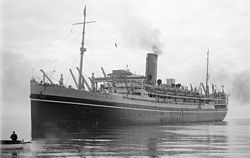Ranchi (ship)
|
||||||||||||||||||||||
|
||||||||||||||||||||||
|
||||||||||||||||||||||
|
||||||||||||||||||||||
|
||||||||||||||||||||||
The Ranchi was a 1925 commissioned passenger ship of the British shipping company Peninsular and Oriental Steam Navigation Company (P&O), which was used in passenger and mail traffic between London and Bombay . During the Second World War , the ship served as an auxiliary cruiser and troop transport under the identification HMS Ranchi (F 15) . After the war again used by P&O in passenger traffic, the Ranchi was broken up in Newport in 1953 .
The ship
In 1923, P&O left four new passenger ships on keel as part of a post-war development program . These were the four ocean liners of the so-called R-class, which were named after cities and regions in India and Pakistan . The Ranpura (1925, 16,688 GRT) and the Ranchi were built by the Hawthorn, Leslie & Company shipyard in Hebburn and the Rawalpindi (1925, 16,695 GRT) and the Rajputana (1926, 16,644 GRT) by Harland & Wolff Heavy Industries Ltd. in Greenock , a branch of the Belfast shipyard Harland & Wolff . The 168.2 meter long and 21.7 meter wide Ranchi was launched as the second of the ships on January 24, 1925.
The ships of the R-class had a volume of over 16,000 gross register tons, a carrying capacity of over 8,000 tons and were equipped with four-cylinder quadruple expansion steam engines that enabled a maximum cruising speed of 17 knots. They each had two propellers , two masts and two chimneys. They were built to transport passengers, freight and mail from London to Bombay and back via the Mediterranean and the Suez Canal ( India Mail and Passenger Service ) and were the first P&O ships to be equipped for the transport of frozen food. On board there was space for 307 first class and 288 second class passengers. The lounge, smoking room and music room of the first class were located amidships on the A-deck. The second class lounges were located in the rear of the A deck and on the B deck. The decorator, pilot and actress Lady Elsie Mackay (1893–1928) was largely responsible for the interior of the four ships. She was the youngest daughter of P&O Chairman James Mackay .
Each time the ship was launched, the wife of a representative of the shipping company or the corresponding shipyard christened the respective ship. At Ranchi , this role was taken over by Elizabeth Jane McIsaac, Lady Addis, the wife of Sir Charles Stewart Addis (1861–1945), a P&O executive director. On July 29, 1925, the Ranchi was completed. Shortly after the handover to the shipping company, it drove to Cowes on the Isle of Wight in time for the start of the annual Cowes Week . The Earl of Inchcape invited numerous guests to visit the new ship and let the Ranchi make an excursion around the Isle of Wight. She stayed in Cowes for three days and got as much attention there as the royal yacht.
World War II and later years
On August 27, 1939, shortly before the outbreak of the Second World War, the Ranchi was requested by the Royal Navy and put into service on October 23, 1939 as an armed auxiliary cruiser (Armed Merchant Cruiser), where it received the tactical identification F15. It was equipped with eight 152-mm guns and two 76-mm guns. The Ranchi's three sister ships were also converted into auxiliary cruisers.
From October 1939 to February 1942, the Ranchi served as an escort vehicle for ship convoys in the Royal Navy Association East Indies Station . From March 1942 to January 1943, it was part of the Eastern Fleet , which was created from the merger of the East Indies Station and the China Station . On March 16, 1943, the Ranchi was transferred to the Ministry of War Transport (MoWT), which from then on used it as a troop transport . After the war ended, she repatriated former prisoners of war and interned civilians from Japanese prisoner of war camps.
On July 18, 1947, the ship was returned to P&O. The Ranchi was completely renovated in Southampton and London, with one of the chimneys removed. On June 17, 1948, the Ranchi in Tilbury ran out on its first post-war voyage. From 1948 to 1952 she served as an emigration ship , making 15 crossings from Great Britain to Australia and back. On January 19, 1953, the Ranchi arrived to be scrapped in Newport, Wales.
Web links
- Detailed description of the ships of P & O's R-Class ( Memento from October 18, 2012 in the Internet Archive )
- Postcard of the Ranchi with two chimneys

